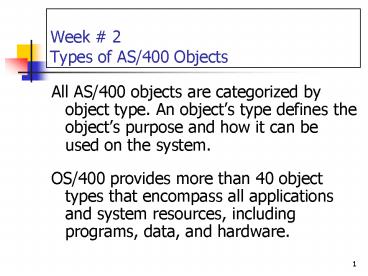Week
1 / 14
Title: Week
1
Week 2Types of AS/400 Objects
- All AS/400 objects are categorized by object
type. An objects type defines the objects
purpose and how it can be used on the system. - OS/400 provides more than 40 object types that
encompass all applications and system resources,
including programs, data, and hardware.
2
Week 2Types of AS/400 Objects (Continued)
- Object type Object description Attribute
(subtype) - CMD Command --
- FILE File PF -SRC (Source File)
-
PF -DTA (Physical file) - LF (Logical file)
- DSPF (Display file)
- PRTF (Printer file)
- JOBD Job description --
- LIB Library --
- OUTQ Output queue --
- PGM Program (executable) Source language
- (e.g., CBL, CLP, RPG)
- QRYDFN Query definition --
- USRPRF User profile --
3
Week 2Types of AS/400 Objects (Continued)
- When you create an object and give it a name, the
system assigns the object type, as determined by
the command you used. - Examples
- Command CRTUSRPRF (Create User Profile)
generates the object type USRPRF - Command CRTLIB (Create Library) generates the
object type LIB
4
Week 2Types of AS/400 Objects (Continued)
- Some CL commands work with any type of object,
but there are object types that have certain CL
commands that can be used only for that type. - Examples
- DSPOBJD (Display Object Description) command
works for objects of any type - DSPUSRPRF (Display User Profile) command works
only for USRPRF objects
5
Week 2 Types of AS/400 Objects (Continued)
- When you create an object, it goes into a
(User) library (unless the object created is, in
fact, a library). This is not a physical
collection of objects but a single-level
directory to a group of related objects.
6
Week 2 Types of AS/400 Objects (Continued)
- A library also provides a logical reference to
objects by using address pointers. - The type and authorization level of each object
is associated with the library entry for that
object. - (Present whiteboard illustration now)
7
Week 2 Requesting an Object
- When you request an object (by selecting a menu
option or by entering a command), it usually is
not necessary to specify the library name in
which the object resides. - You specify an object name (up to10-characters
without a library reference), and the system
searches the jobs current library list to locate
an object matching the specified name and type
appropriate for the request.
8
Week 2 Requesting an Object (Continued)
- Example You want to use the CALL command to
execute a program. The CALL commands only
required parameter is the name of the program so
if you want to run a program named ACTCUS (to
list all active accounts in a customer file), you
would enter the command - CALL ACTCUS
9
Week 2 Requesting an Object (Continued)
- The only valid object type for a CALL command is
PGM, so if you include the object type in the
library entry, the system can determine whether
its type is appropriate for the requested
operation without having to locate and load the
actual object.
10
Week 2 Qualified/Unqualified Names
- To run, for example, program ACTCUS in library
TSTLIB1, proceed in two ways - Change the library list, or
- Use a qualified name for the object (the most
direct because it includes a reference to a
library the 10-character object name), which
would take the form - CALL libref/objname
11
Week 2 Qualified/Unqualified Names (Continued)
- In the form libref/objname, libref is an explicit
library-object name therefore, to execute
program ATCUS in library TSTLIB1, specify the
following CALL command - CALL TSTLIB1/ACTCUS
- Here, the system searches only library TSTLIB1
for program ACTCUS.
12
Week 2 Qualified/Unqualified Names (Continued)
- The library specified in an explicit qualified
name does not need to be in your library list,
but you (the requester) must be authorized not
only to use that library but also to use the
object within the library. The first thing the
system does is determine whether you have proper
authority to the library you named. - When you use a simple unqualified name, the
search for an object is limited to your library
list. The system determined that were authorized
to use the library-list libraries when your job
began. (Attempting to add to your library list a
library to which you are not authorized will
cause an error.)
13
Week 2 Qualified/Unqualified Names (Continued)
- If you are authorized to the library specified in
an explicit qualified name but the system cannot
find a matching object name of the appropriate
type, or if you are not authorized to use the
object, the system does not search beyond the
specified library. Instead, the system returns a
message such as Object OBJNAME in library
LIBNAME not found or Not authorized to object
OBJNAME in library LIBNAME.
14
Week 2 Qualified/Unqualified Names (Continued)
- It might be necessary to use a qualified name if
- Objects with the same name and type exist in more
than one library in your library list - You need an object that is not in any library in
your library list - To use a qualified name, you need authority
adequate for the intended use, both to the object
and library.































